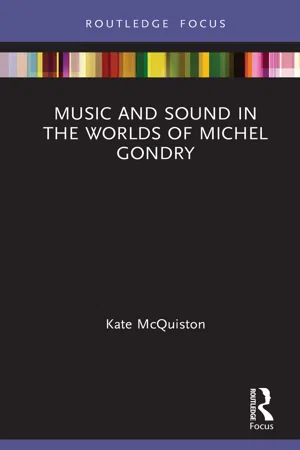It’s the first film I remember. It’s the film I like to rewatch the best. When you’re young, you’re very receptive to all the stuff you see, the emotions. And then you try all the time to match up with those sensations. So in this sense it may have changed my life because I’m always trying to re-create this feeling of watching this movie.
Gondry’s ambition to create emotionally affecting work retains a connection to feelings and fantasies of childhood. Gondry describes his childhood perception as especially vivid and principally concerned with fantasies and dreams, like the wish to fly, and nightmares and a fear of death. Beyond the immediate emotional appeal of Le voyage en ballon, Gondry admired Lamorisse’s working methods, which included having his son film while suspended from a helicopter. Gondry marvels, “It’s not like studio stuff. It’s really flying.”8 Gondry emulated Lamorisse when filming Björk’s video for “Joga” while hanging out of a helicopter. Childlike feelings are often at the heart of Gondry’s work; “For me, when you produce art, you’re trying to be in touch with who you were as a child, that purity of happiness.”9
Homage is a central thematic interest as well as a practice in Gondry’s work, and how things are made is important to him. In interviews about how he approaches his work, he has named a wide array of filmmakers, many of them French. Gondry imagines Georges Méliès as a kindred spirit interested in stretching the resources and possibilities of the camera:
Méliès was one of the first people to witness a screening of the Frères Lumière in Paris in 1895. He immediately thought of the camera as a tool to improve his magical tricks. Interestingly, I had the same way of thinking—when I had the ability to use a camera, I always used it to explore what I could do with it, pushing the limits, and always being self-sufficient.10
Also highly important to Gondry are Jean Vigo’s film L’Atalante and the films of Alain Resnais, whom he calls “one of my favorite directors in France and in the world.” Gondry explains: “I love how he finds humanity in science, which I admire, because generally science is regarded as being cold, and just calculation and I don’t believe so. His films are geometrical, and they are human and poetic.”11 Gondry also learned from Resnais’s inventive and conspicuous editing, including cuts from scenes rich with music to scenes of silence, and cutting to images without preparation or explanation.
Outside of France, Gondry points to Yuri Norstein’s stop-motion animated film, The Hedgehog in the Fog (1975), as particularly influential. Its influence on the video for “Human Behavior” is evident,12 and the hedgehog’s worried face comes back in the form of Thom Yorke as a mouse on a mic stand in the “Knives Out” video, and in the mouse in Mood Indigo. Gondry expresses admiration likewise for Charlie Chaplin and Charlie Bowers, for the warmth of Vittorio de Sica’s movies, for Buster Keaton’s physical comedy and elaborate tricks, for the animation of Tex Avery, for the films of Ingmar Bergman and those of David Lynch—another director with art training and musical skill. The animation of Norman McLaren’s films, which he compares to “mini operas,” provokes Gondry to marvel:
He even created sounds with images by painting directly onto the sound stripe to create the melody. So the way he could illustrate the music—sometimes very literally, sometimes in a more abstract way—had a great influence on me and inspired me a lot.13
Gondry has named among his favorite films an eclectic bunch, all of which show ambitious imagination or engage science fiction tropes: The Time Machine (George Pal), The Incredible Shrinking Man (Jack Arnold), Phase IV (Saul Bass), The Thin Blue Line (Errol Morris), Dancer in the Dark (Lars von Trier), The Phantom of Liberty (Luis Buñuel), Singin’ in the Rain (Stanley Donen, Gene Kelly), Groundhog Day (Harold Ramis), and Back to the Future (Robert Zemeckis). In television, Gondry is an enthusiastic fan of Mr. Show, whose episodes he claims to know by heart. He also claims to enjoy watching documentaries even more than feature films and has named Night at the Roxbury (John Fortenberry) and Stuck on You (Farrelly Brothers) as guilty pleasures.
Elements of Auteurism: Autobiography, Recurrence, Appearing on Screen, Dreams
Among Gondry’s polarizing qualities are his childishness, lack of substance in storyline or depth in favor of original effects and concepts, and autobiographical elements. Whether tender and innocent or oneiric and grotesque, solipsistic qualities of Gondry’s work have alienated some audiences. Gondry freely admits to drawing on his own experience for material; moments based on his life become all the more evident in the films based on scripts written by Gondry himself, or by Gondry and co-authors (for the films beginning with The Science of Sleep).
Gondry’s sensitivity to the experiences of childhood and early adolescence plays out in the two-part documentary I’ve Been 12 Forever (2003); Gondry models Stéphane in The Science of Sleep on his young adult self, and Daniel in Microbe et Gasoil on his fourteen-year-old self. Gondry’s short film La Lettre (1998) joins Microbe et Gasoil, and particular scenes in Eternal Sunshine of the Spotless Mind, in depicting emotionally charged intimacy, shame, anxiety, and rejection. Characters even restate cutting remarks of Gondry’s former girlfriends, such as Stephanie’s comment that it is unattractive for a man to cry, and Laura’s rejection of Daniel’s invitation to dance. In 2007, Gondry described The Science of Sleep as “one hundred percent personal, about things that happened to me. It’s sort of a compilation.”14 In 2016 he admitted: “Each film I’ve done reminds me of a breakup which, generally, is me being dumped, so it’s painful ...
